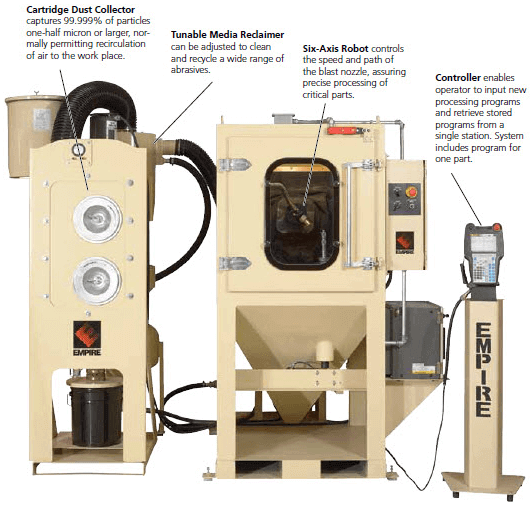
Robotic Blasting is becoming more and more prevalent in the manufacturing process. Companies are looking to increase efficiencies and lower costs. With robotic blasting equipment in place, the operation can run in a continuous mode. Operators are able to run multiple machines and become more efficient.
Top Considerations for Robotic Blasting:
Control and Repeatability:
As an operator gets tired they lose focus and attention. Robotics provides repeatability and long run times without straying from the specification. This ensures consistent high quality while reducing the defects, rejects and rework. The bottom line is meeting the specifications for each part with process control that happens consistently, every time.
Efficiency:
With a robot, you can control where you are blasting all the time. During a manual operation, the blasting frequently continues off the part while the operator repositions his grasp. Over-blasting is also a concern with manual systems, as operators often blast longer than necessary or over the same area twice to ensure full coverage. In both scenarios, the system is unnecessarily consuming compressed air, media, and most importantly, time. This is inefficient in addition to general fatigue for the operator.
Less Resources and Lower Costs:
Robotic Blasting reduces the need for more people. This dramatically reduces costs and is a main reason that automation is becoming more prevalent. Additionally, robotics will reduce the amount of resources used to generate a finished part. This ranges from energy, compressed air, blasting media, floor space, machine maintenance, and rework.
Robotic blasting is used in a wide array of applications and can accommodate large and complex parts. This enables users to assure the quality control and deliver the process validation so often required by
today’s aerospace, automotive and medical sectors.
Thirty Quick Benefits of Robotic Blasting
Improve Cabinet Component Life
Improve Product Quality
Improve Employee Safety
Improve Manufacturing Flexibility
Improve Operations Reliability
Improve Production Data
Improve Regulatory Compliance
Improve Decision-Making
Improve Product Yields
Improve Product Flow
Improve Return-on-Capital
Improve Employee Morale
Improve Revenue & Profits
Improve Time to Market
Reduce Air Consumption
Reduce Media Consumption
Reduce Media Disposal
Reduce Manufacturing Costs
Reduce Maintenance Costs
Reduce Utility Costs
Reduce Consumables Cost
Reduce Scrap and Waste Cost
Reduce Error and Return Cost
Reduce Product Development Time
Reduce Production Changeover
Reduce Floor Space
Reduce Production Variability
Reduce Schedule Variability
Reduce Production Failure Modes
Reduce Hazardous Exposure
